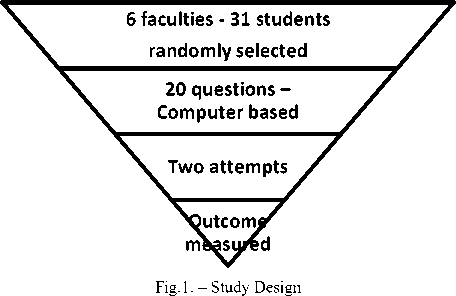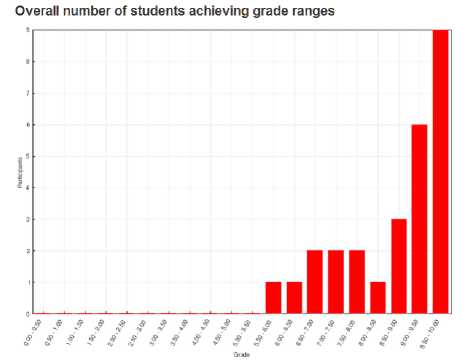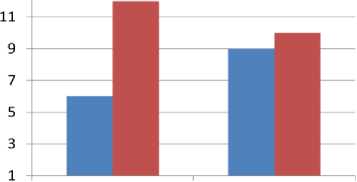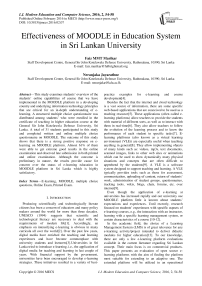Effectiveness of MOODLE in Education System in Sri Lankan University
Автор: Faiz MMT Marikar, Neranjaka Jayarathne
Журнал: International Journal of Modern Education and Computer Science (IJMECS) @ijmecs
Статья в выпуске: 2 vol.8, 2016 года.
Бесплатный доступ
This study examines students' overview of the students' online capabilities of course that we have implemented in the MOODLE platform in a developing country and underlying information technology principles that are critical for an in-depth understanding of e-learning. A structured multiple choice questionnaire was distributed among students' who were enrolled in the certificate of teaching in higher education course at the General Sir John Kotelawela Defence University, Sri Lanka. A total of 31 students participated in this study and completed written and online multiple choice questionnaire on MOODLE. The outcome of this study shows that there is a strong positive response on e-learning on MOODLE platform. Almost 61% of them were able to get extreme good results in the online examination and observed late submission in both printed and online examination. Although the outcome is preliminary in nature, the results provide cause for concern over the status of e-learning education in MOODLE platform in Sri Lanka which is highly satisfactory.
E-learning, MOODLE, multiple choice questions, Online Exam, Printed Exam
Короткий адрес: https://sciup.org/15014840
IDR: 15014840
Текст научной статьи Effectiveness of MOODLE in Education System in Sri Lankan University
Published Online February 2016 in MECS DOI: 10.5815/ijmecs.2016.02.07
-
I. Introduction
Producing scientifically and technologically literate citizens has been a concern of educators and many policy makers around the world for more than three decades. UNESCO (1994) suggests that scientific and technological literacy are necessary to deal with the requirements of modern life[1]. Accordingly, an emphasis on intensifying e-learning is obvious in many curricula all over the world[2]. Over the past few years, digital media have enriched the teaching and learning experiences and have become commonplace with university students and lecturers[3].Universities in Sri Lanka tried to introduce e-learning, i.e., the application of digital media for teaching and learning in last couple of years. With financial support by the government, universities have been encouraged to develop e-learning strategies. These initiatives resulted in a variety of best-
- practice examples for e-learning and course development[4].
Besides the fact that the internet and cloud technology is a vast source of information, there are some specific web-based applications that are conceived to be used as a teaching resource[5]. These applications (often called elearning platforms) allow teachers to provide the students with material of different sorts, as well as to interact with them in real-time[6]. They also allow teachers to follow the evolution of the learning process and to know the performance of each student in specific tasks[7]. Elearning platforms (also known as a virtual learning environment (VLE)) are especially useful when teaching anything in general[8]. They allow implementing objects of many kinds such as: videos, mp3s, text documents, scanned images, links to other web sites or animations which can be used to show dynamically many physical situations and concepts that are often difficult to apprehend by the students[9]. A VLE is a software system designed to support teaching and learning. A VLE typically provides tools such as those for assessment, communication, uploading of content, return of students’ work, administration of student groups, questionnaires, tracking tools, wikis, blogs, chats, forums, etc. over internet[9].
Even though the application of e-learning at universities has increased rapidly and our university use MOODLE platform little is known about students’ expectations and experiences. Until recently, research focused on students’ experiences with specific aspects of e-learning courses, e.g., the interaction with an instructor, learning with a specific learning management system, or certain characteristics of a course [10-12].
In the academic field, the choice of a Learning Management System (LMS) is of great relevance for any e-learning activity/project intended to deliver didactic modules for higher education[13]. To our knowledge, there are only a few e-learning platform evaluations available in the current literature regarding Sri Lankan concept. Their main focus is on commercial products. This paper presents an evaluation of open source elearning platforms with the aim of finding the platform most suitable for extending to an adaptive one. The extended platform will be utilized in an operational teaching environment. Therefore, the overall functionality of the platform is as important as the adaptation capabilities, and the evaluation treats both issues.
-
II. Methodology
In this study we have examined students’ capabilities of self learning with e-learning concepts and knowledge on the learning and management system (LMS) in university system. This topic was judged to be extremely important to have a conceptual understanding of what is e-learning and to find out in detail knowledge on current trends in MOODLE. The study design in this study is presented in the Fig. 1. Approval for the study was obtained from the Staff Development Center. Target population of this study represents all six faculties from the university. All students were given a series of online lectures and materials related to e-learning platform known as MOODLE. Thirty one students who participated in the consecutive e-learning and gave their consent were included in the study. The purpose of the study was explained to the students at the beginning of the lecture. The students who consented to participate in the study were individually tagged and given them a tag. They were allocated to a group the e-learning based practical spot test group ( n =31).

Questionnaire Used
A questionnaire, on self generated MOODLE was introduced ‘‘Learning MOODLE with e-learning’’. The data were collected by means of the questionnaire consisted of 20 items including multiple choice questions which generated in the MOODLE platform. The questionnaire was used in Sri Lanka among students for the first time. The use of the questionnaire was justified because it had been prepared by an experienced research group working in e-Learning education and it had already been tested and validated before the distribution online. In addition, the questionnaire was designed to assess conceptual understanding of topics included in the Sri Lankan university curriculum. The question which was used is attached at the bottom of the page.
Research Context and Participants
Thirty one students took part in this study. Six faculties including Law, Medical, Allied Health Sciences, Engineering, Management and Defence equally represent from General Sir John Kotelawela Defence University, Sri Lanka, which was located in Ratmalana, Sri Lanka. All students were employed at the university as lectures. The students learned about basic of e-learning by self learning and all the materials were provided at the MOODLE. The Faculty is a socially and economically diverse community in Western Province of the country and this is the one and only Defence University in this country. The students had the backgrounds knowledge of knowledge on computing and e-learning after completing their 1st year they have to study the subject in certificate in teaching in higher education course. They have been expected to know the answers to the questions asked in the questionnaire used in this study.
Administration of Questionnaire among the Students
The questionnaire was administered among each of the respective students at the University MOODLE within a period of a week they have to answer the entire question online. They have been given option to browse the internet and given two chances to answer a question. Care was taken to avoid exchanging the students’ information or ideas.
Data Analysis
To analyze the questions, we compared informal reasoning displayed by individuals representing high and low level of understanding of e-leaning with the computer aided MOODLE system. The validity of the translation was independently assessed by two observers competent in English language. We analyzed our data as a balanced figure in a percentage of application. For statistical analysis, we transformed all our data using the basic statistical analysis package.
-
III. Results
Multiple Choice Questions (MCQ)
MCQ are a useful tool for students to test their level of knowledge when it comes for the assessment. All the 20 questions posed there are based on basic concepts of MOODLE previously explained in the self e-Learning who was given in the University MOODLE site. MOODLE provides a wide range of quiz types. For our online course we have chosen questions that can be of MCQ with two attempts. Apart from the questions themselves, there are many parameters one can adjust in the quizzes: the date at which the quiz is available, the time they have got to solve it, the number of tries; with the wrong answers the teacher can send a comment to the student. They know the score they have gotten in realtime. When a quiz is created, one can define the number of tries one student can do. Students can therefore try again when they think they have improved the knowledge they have on these issues. Each time the students try to solve one of them the questions appear in different order.
In the following figure (Fig. 2) 87% participation was bserved and 61% have obtained above 8 which are highly satisfactory.

Fig.2. Overall Number of Students Achieving Grade Ranges
Comparison of Collections of Problems and Exercises with Given Time
One crucial aspect of the process of learning MOODLE is to develop the ability to use the system in their teaching and learning process. Students usually find it difficult to apply because they are come from different scheme, and they have only seen in the classroom, so it is important to provide them with a collection of exercises that help them to accomplish this task. For this reason, we have uploaded to MOODLE a complete set of resource materials, ranging from what is MOODLE to application of it. For comparison a printed copy was given simultaneously. One thing we observed whether it is printed or online delay submission is common among the students (Fig. 3) online it was 45% and printed 60%.

N = 15 (Printed)
N-22 (Online)

Ontime Late
Fig.3. Submission of Online and Printed Documents
Students’ Expectations and their Contribution to Course Outcomes
Students’ expectations contributing to course outcomes (achievements and satisfaction) were investigated. A simple statistical analysis was carried out with the items of students’ expectations as independent variables and achievement were measured in a simple analysis. (cf. descriptive summary statistics for expectations given in Table 1). We have observed that all most all the items are satisfactory except maintaining participant’s interest and motivation part is lacking in e-Learning platform.
Table 1. Descriptive Statistics of Students’ Expectations.
|
Item |
Mean |
SD |
Max |
|
Adequacy of Content |
3.29 |
0.35 |
3.52 |
|
Clarity in content |
3.31 |
0.43 |
3.56 |
|
Relevance |
3.25 |
0.37 |
3.58 |
|
Conduct Sessions in an organized and well planned manner |
3.28 |
0.45 |
3.56 |
|
Maintain participants interst and motivated |
3.02 |
0.47 |
3.51 |
|
Delivery Of the Lecture |
3.23 |
0.40 |
3.54 |
|
Clarity |
3.38 |
0.46 |
3.59 |
|
Relevance |
3.30 |
0.37 |
3.61 |
|
Coverage |
3.24 |
0.35 |
3.55 |
|
Provides Guidence about the Subject and Shares Additional knowledge |
3.20 |
0.38 |
3.30 |
|
Content of learn |
3.28 |
0.39 |
3.51 |
|
Clarity in Presentation |
3.30 |
0.44 |
3.57 |
|
Time Management of Lecturer |
3.35 |
0.31 |
3.57 |
|
Knowledge added |
3.25 |
0.36 |
3.49 |
|
Quality of ppt |
3.08 |
0.41 |
3.43 |
|
Overall learning environment |
3.18 |
0.35 |
3.46 |
|
Session Overall |
3.23 |
0.37 |
3.48 |
-
IV. Discussion
The results of the research contribute to an understanding of which characteristics of an e-learning course and learning behaviors are important for learning achievements and satisfaction. The final performance on the study varied between technical and not technical disciplines. The scores of the personnel from faculties such as law and management were marginally less in value than those who were from faculties with more technical background such as engineering. Even though the people from both of these categories are equivalent in literacy in information technology, the former category showed some reluctance when the answers should come from an easy internet search. Since the online module was self-contained in Moodle a learner should login, watch all the videos and refer to the material on the cloud and come up with the answers for the questionnaire. Correct responses for some questions were not present in the given material. These questions were put there to force the learner to search the cloud. In particular these were question 3 and 20. The former group of people failed significantly in these two questions. Since this type of course is carried out for the first time there was reluctance to follow this self-sustained course online all over the selected group. The online material delivery was heavily questioned. However when the users got familiar with the usage of the technology they were convinced. The technology is much effective in short course delivery.
-
V. Conclusion
In our study, two aspects contribute strongly to learning achievements and course satisfaction: students’ achievement goals and the instructor. Students who considered gains in competencies as especially important, experienced higher achievements. Furthermore, the results of our study emphasize the instructor’s expertise and role as a counselor and facilitator in learning. The instructor does not become less important in e-learning. On the contrary, students experience the instructor’s support and expertise as especially important for the acquisition of knowledge, skills, and competences and for course satisfaction. Other than these variables, only a few others contribute to learning achievements or satisfaction: students’ motivation, opportunities for self-regulated and collaborative learning, and the clarity of the course structure. Instructors need a high degree of didactic expertise in the implementation of an online course. Yet, not all instructors are sufficiently skilled in the implementation of e-learning as indicated by students’ assessments. Until recently, however, only a few universities in Austria offer continuing education and training for e-learning instructors [4]. The results of our study stress the importance of such further training. In addition to that [14] describes a project where courses are collaboratively developed by faculty staff, industry experts and students. This type of effort in a developing country like Sri Lanka would increase the industrial applicability of learning material as well as helping the academics currency up to date. The industry will also gain from the state of the art research carried out by academics [15] studies student centered learning paradigm in learning high order skills. Here the importance of co-operative learning was discouraged. In the research explained by this paper quality was measured at a minimum level. This can be further developed using a method similar to which is explained in [16].
Acknowledgment
The authors wish to thank all the lectures who participated in this study at General Sir John Kotelawala Defence University, Sri Lanka.
Список литературы Effectiveness of MOODLE in Education System in Sri Lankan University
- UNESCO, "Inclusive Education." vol. 2014, 1994.
- J. Kaminski, "Editorial: Moodle – A user-friendly, open source course management system.," Online Journal of Nursing Informatics vol. 9, p. 1, 2005.
- S. S. Liaw, H. M. Huang, and G. D. Chen, "Surveying instructor and learner attitudes toward e-learning," Computers & Education, vol. 49, pp. 1066–1080, 2007.
- S. Narciss, A. Proske, and H. Körndle, "Promoting self-regulated learning in web-based learning environments," Computers in Human Behavior, vol. 23, pp. 1126–1144, 2007.
- D. Y. Shee and Y. S. Wang, "Multi-criteria evaluation of the web-based e-learning system: A methodology based on learner satisfaction and its applications," Computers & Educational Technology & Society, vol. 50, pp. 894-905, 2008.
- T. Martín-Blas and A. Serrano-Fernández, "The role of new technologies in the learning process: Moodle as a teaching tool in Physics," Computers & Education, vol. 52, pp. 35–44, 2009.
- B. Beatty and C. Ulasewicz, "Online teaching and learning in transition: Faculty perspectives on moving from blackboard to the Moodle learning management system," TechTrends, vol. 50, pp. 36-45, 2006.
- P. R. Pintrich and D. H. Schunk, Motivation in education. London: Prentice Hall, 1996.
- M. Weller, Virtual learning environments: Using, choosing and developing your VLE. London: Routledge, 2007.
- M. Engelbrecht, "Adapting to changing expectations: Postgraduate students' experience of an e-learning tax program," Computers & Education, vol. 45, pp. 217–229, 2005.
- S. Alexander and T. Golja, "Using students' experiences to derive quality in an e-Learning system: An institution's perspective," Educational Technology & Society, vol. 10, pp. 17–33, 2007.
- H. Coates, R. James, and G. Baldwin, "A critical examination of the effects of learning management systems on university teaching and learning," Tertiary Education and Management, vol. 11, pp. 19-36, 2005.
- M. Bruinsma, "Motivation, cognitive processing and achievement in higher education," Learning and Instruction, vol. 14, pp. 549–568, 2004.
- R. Reis, "The Stanford University Electronic Learning Portfolios project," in 28th Annual Frontiers in Education Conference, 1998.
- S. Bermejo, "Cooperative electronic learning in virtual laboratories through forums," IEEE Transactions on Education, vol. 48, pp. 140-149, 2005.
- D. Dinevski, J. Jakonc, M. Lokar, and B. Znidar, "A model for quality assessment of electronic learning material," in 32nd International Conference onInformation Technology Interfaces (ITI), Cavtat/Dubrovnik, 2010.


